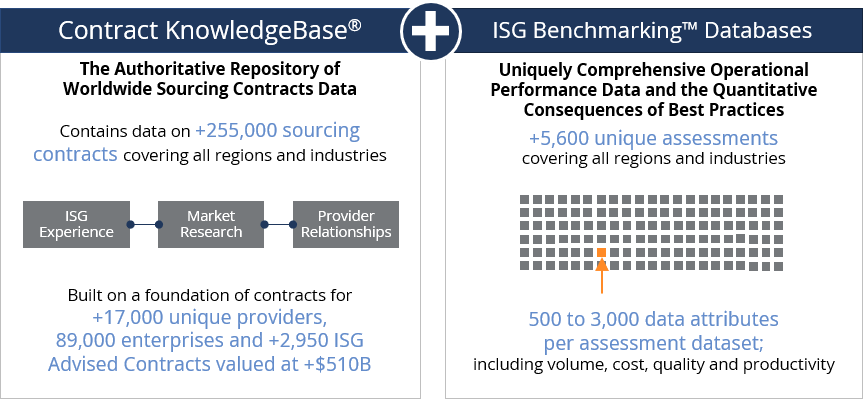5 Ways to Optimize Application Sourcing Costs in an AI-Enabled Market
Application sourcing —software, support, labor and managed services — presents a prime opportunity to reduce spend and improve value realization.



We have +15 years' experience helping enterprise clients compare defined services to the market.
We have the data and know-how to help you benchmark cost, quality and productivity across all functional areas of business and IT, including:
Find out the right benchmarking services for your needs and strategic objectives.

![]()
Price
Staffing rates, contract pricing and competitiveness

Cost
Total cost of ownership (TCO) and industry benchmarks
![]()
Performance
SLAs, user experience and provider relationships

Contract
Price, terms and conditions
Are total staffing levels and staffing utilization right for each functional area?
How do our level of assets compare? Are we providing the right service levels to users?
Are we spending the right amount of money in total, and by major functional area?
Where are the variances from leading practices?
Why and where are there gaps? How do we drive sustainable improvement?
What are the high impact, high ROI changes we can make in the immediate term?
Are there services currently provided in-house that should be outsourced, or vice versa?
What complexity or constraints could be alleviated through automation or simplification?
Outsourcing contracts become uncompetitive over time, but it’s difficult to know when it will happen – or by how much.
Whether you want to benchmark your outsourcing contracts’ price, compare your internal service delivery cost to the market or both, ISG gives you at-a-glance visibility into price competitiveness via a single-pane dashboard, plus access to deep dives into real-time IT industry market price intelligence.
In addition to the above project based price benchmarking services, you can also monitor the price competitiveness of your contracts in real time using using the ISG Probenchmark® price monitoring service.
Acting on timely, accurate and actionable price data allows enterprises to more quickly respond to changes in market prices and make more strategic decisions regarding their IT services.
To get a complete picture of your landscape, you need to understand your service quality and personnel productivity, potential efficiencies and gaps, user satisfaction, and how all these elements relate to cost and compare to the market.
We offer a holistic benchmarking solution that gives real-time, online dashboard visibility into the three key components of performance:
By comparing your spend, staffing allocations and performance across the enterprise, we help you identify opportunities to improve your financial and operational performance.
TCO Benchmark: Compares your total cost of ownership against industry standards of cost, quality and productivity for a variety of IT products and services.
Industry Benchmark: Compares costs against industry metrics, such as IT spend as a percent of revenue.
Get real-time access to cost benchmarking data with ISG Inform™.
Build a defense against the risks of fixed-price long-term contracts. Compare your contract price, terms and conditions to the market and know when your contract falls out of favor.
The terms and conditions of your contracts set guidelines of acceptable behavior, but they are evolving entities – and you need to manage that evolution. A commitment to benchmarking your contracts is a commitment to progress and improvement.
An ISG contract terms and conditions assessment can:
KPIs and SLAs are essential for tracking performance in terms of achieving strategic goals and making decisions. In the best of cases, KPIs can serve as an early warning system to let you know when you are heading off course and where
action might be needed.
An ISG performance benchmark compares your performance against industry peers and leaders and gives you a cost-effective approach to share, compare, improve, and transform internal functions and processes.

SLA Benchmark
assesses service levels against the market, including both performance levels and structure

User Experience Benchmark
measures the impact of technology on users, including customer satisfaction
ISG is a leader in proprietary research, advisory consulting and executive event services focused on market trends and disruptive technologies.
Get the insight and guidance you need to accelerate growth and create more value.
Learn MoreIn the current business landscape, enterprises continue to face disruptions such as tariffs, wars, political unrest and climate shocks. Hence, it has become mandatory for supply chain leaders to look beyond temporary fixes and pursue larger transformations to gain a competitive advantage. A siloed or process specific uplift provides short-term relief, but building future-ready, connected, intelligent and sustainable supply chains requires a comprehensive revamp, driven by technologies such as AI, analytics, supplier relationship management (SRM) and automation. This year’s assessment highlights a major shift in chief supplier officers’ approach, focusing more on enhancing process optimization and operational efficiency than merely targeting cost savings to stay ahead of the competition.
Autonomous commerce is no longer a distant prospect; it is actively transforming procurement systems, digital marketplaces and B2B revenue platforms today. Intelligent systems can now interpret buying intent, evaluate margin risk and negotiate terms with increasing sophistication. Yet, according to ISG’s State of Agentic AI Market Report, only 25% of artificial intelligence (AI) solutions operate fully autonomously, while 45% still rely on human oversight. This cautious pace highlights a critical leadership challenge: organizations that delay adoption risk falling behind in efficiency and revenue growth, while premature or poorly governed autonomy threatens brand reputation and customer trust. ISG asserts that through 2027, providers will develop agentic AI capabilities to automate much of the revenue life cycle for renewal and expansion offers, improving the customer experience and resulting in increased lifetime value.
There is a shift underway in how enterprises structure their software stacks in relation to contact centers. Multiple factors have coalesced to reduce the importance of the traditional call handling infrastructure (i.e., the ACD) as the foundational element of the tech stack. It no longer has to be the focus of buying or deployment decisions. It’s been superseded by a more extensible (but complex) combination of voice and data network providers, Communication-Platform-as-a-Service (CPaaS) tools and cloud-based enterprise platforms. Contact centers also need systems to control the movement and use of customer data, and this is affecting buying decisions.
Over the past two years, I’ve led and operated as a practitioner in a sustained, feels-like-a-seven-day cadence to build what I believe is the most comprehensive enterprise software research foundation in the industry. Joining ISG after two decades of being a CEO and Chief Research Officer running a specialized research and advisory firm—Ventana Research—the new mandate was clear: expand software coverage more than 5x from 25 to 125+ categories and industrialize delivery through the ISG Buyers Guides, now accessible in concise, readable and listenable formats. That mission is complete: we’ve scaled operations across more than five consecutive quarters and expanded to a highly efficient global research engine that consistently delivers breadth, depth and enterprise-grade perspective.
The AWS ecosystem in the U.S. is undergoing a significant transformation, with service providers increasingly focusing on delivering advanced, value-driven cloud capabilities. This evolution is marked by substantial investments in emerging technologies, particularly generative AI (GenAI), agentic AI and data analytics, alongside continued emphasis on large-scale cloud migration, modernization and enterprise application support. Providers are developing highly specialized, often industryspecific solutions, and deepening their strategic alignment with AWS to deliver measurable business outcomes for their clients. The market is characterized by a strong drive towards innovation, operational efficiency and a refined approach to cloud adoption, moving beyond basic infrastructure provision to holistic, AIinfused digital transformations.
Benchmarks ground strategy in reality by showing how you compare to peers on cost and performance. Used well, benchmarks reveal outliers to investigate and areas for improvement without pushing you to chase the lowest price or sacrifice quality.
Benchmarks reveal market-competitive rates and terms, letting you renegotiate with current providers instead of running a full RFP. That shortens time-to-value and reduces disruption while giving you the confidence that you’re paying a fair, defensible price.
A TCO benchmark looks at the whole solution, design, volumes, service levels, operating model and efficiency levers, so you spot bigger, more sustainable savings. Price-only benchmarks compare line items and can miss structural changes that lower overall cost.
No, benchmarks work best for fungible offerings with multiple suppliers. For proprietary products (e.g., software), pricing is shaped by bundles and SKU choices, so optimizing the bill of materials and total cost of ownership matters as much as discount level.

